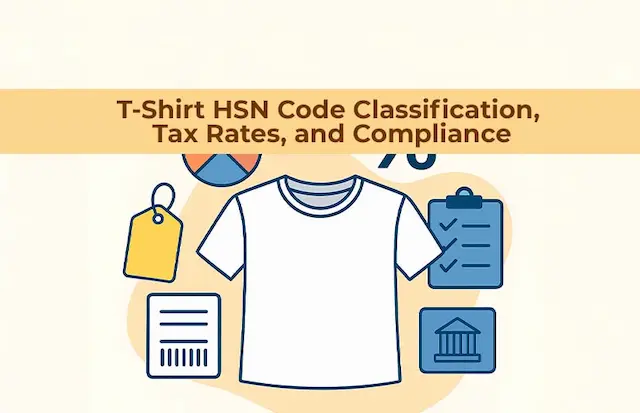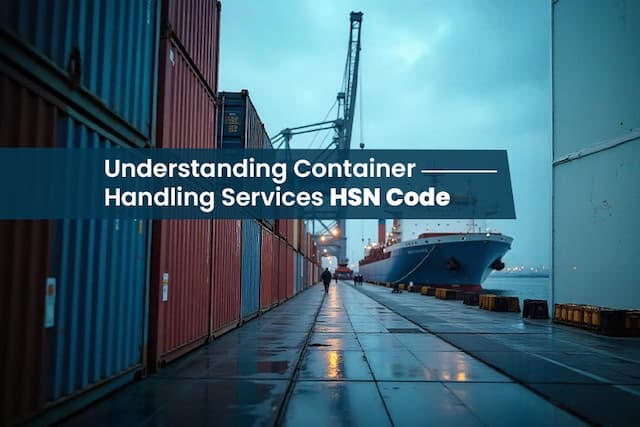With the GST system in India, knowing the difference between HSN and SAC codes is not just helpful – it’s critical for getting the invoicing right. If you deal in products or services, you must have heard terms like HSN Code and SAC. But what do these terms mean, and how do they affect the entire invoicing process?
Understanding the differences between these two codes will keep you away from all compliance issues and help you ensure accuracy in invoices and your business off the audit radar, so let’s get into the details.
What is an HSN Code?
The HSN code in GST refers to the Harmonized System of Nomenclature, which is a system applicable globally and devised by the World Customs Organization (WCO) for the systematic classification of goods for tax and trade purposes. India adopted this system under GST to standardize the classification of goods and simplify tax reporting and tracking.
Each HSN code is a unique number ranging from 6 to 8 digits. Each set offers a deeper level of classification from large categories down to specific items. For example, the prefix code for textile goods would be completely different from the codes for electronics.
SAC – The Code for Services
The Services Accounting Code refers to services that fall under the GST classification, whereas the HSN classification is limited to products. Services cannot be physically held, counted, or measured like goods. The Services Accounting Code helps the tax system find out and classify services with accuracy.
This 6-digit code begins with ‘99’, while the following four digits provide a detailed classification of the service category, such as legal, education, IT, or hospitality. With the help of this structured approach, service providers can issue GST-compliant invoices that are fair and easy to validate.
Why These Codes Matter in Invoicing
An invoice is more than the act of issuing a bill; it is a legal document that must be accurate and comply with GST regulations. This is where the HSN or SAC codes come in. These codes ensure that the right tax rate is being applied, which is relevant in cases of maximizing Input Tax Credit (ITC) claims and evading penalties.
The inclusion of the requisite code on your invoice is mandatory under the GST invoicing rules when your turnover exceeds the prescribed threshold. Absence or wrong codes mean the filing will be delayed, ITC will be lost, or a scrutiny by tax authorities will ensue.
HSN Code Uses Based on Turnover
Not all businesses are required to use an elaborate HSN code for goods. The system allows for some flexibility based on your turnover. The levels go as follows –
- Up to Rs 5 crore turnover – No HSNs or just a 4-digit HSN is needed.
- HSN codes become mandatory for any turnover above Rs. 5 crore.
- 8-digit HSN codes are applicable for exports and imports.
This graded requirement makes it easy for small businesses and ensures that bigger players offer in-depth information for regulatory clarity.
Applicability of SAC Across Various Sectors
SAC codes are used to classify service providers by businesses. If you are a freelancer, consultancy, digital marketing, or even have a fully-fledged agency, you are supposed to apply a specific SAC code for all your GST invoices.
Wrong SAC usage may result in mismatched data in the GST returns, affecting compliance ratings and possibly delaying refunds. For example, advertising and IT services may seem similar; however, they are covered under different SAC codes in GST, attracting different tax implications.
The Technical Structure Behind HSN and SAC
Let’s look at this from a more technical perspective. HSN codes follow a logic based on the category of the product, sub-category, and specific item. Similarly, SAC codes follow a pattern, too –
- The first two digits indicate (99) – It is a service.
- Next two – Broad service category, such as financial services.
- Last two – Define the exact type of service within that category.
This structure helps businesses identify the most accurate code – this is a step towards GST filing accuracy.
HSN Code Example In Real Business
Let’s say you are dealing with home appliances; for instance, selling an air conditioner will legally require you to add the HSN code 84151010 on your invoice. This will give a good amount of clarity and also give your buyer the benefit to claim the appropriate ITC. For B2B businesses, missing this code will financially cripple both you and your client.
SAC Code Example In Professional Services
For example, if you are a freelance content writer providing digital content services. The SAC Code 998361 applies to you for advertising and content creation services. Invoicing this to your client makes it easier for him to validate GST and for you to comply with GST laws without unnecessary notices from the tax department.
How to Figure Out the Right Code?
Many businesses cannot identify the right HSN or SAC. The easiest way of doing this is by referring to your industry-specific documentation or the use of the code finder tool in the GST portal. You can always consult your accountant or tax expert to avoid guesswork.
It is also better to keep updated about the tax codes under GST, as the government regularly revises or recategorizes codes according to economic changes and policy updates. Outdated codes can get you into a lot of trouble, even if your intent is pure.
Conclusion
HSN and SAC may sound like boring tax jargon, but they are important tools that allow you to run a compliant and successful business. It doesn’t matter if you’re selling physical goods or providing services; knowing which code to use, when and how to use HSN and SAC codes makes an enormous difference. So the next time you create an invoice, do not leave the code blank. It is about much more than ticking a box; it is a gateway to truth, transparency, and tax efficiency.
Credlix is a digital platform for supply chain finance, assisting businesses in unlocking up to 95 percent of their invoice value in as less as 24 hours without collateral. Export factoring, purchase order financing, and vendor finance are services that help organizations achieve seamless cash flow and rapid access to working capital. The tech-enabled process takes the simplicity of documentation, offers quick approvals, and supports businesses to scale their operations efficiently without giving away the essence of GST compliance.





